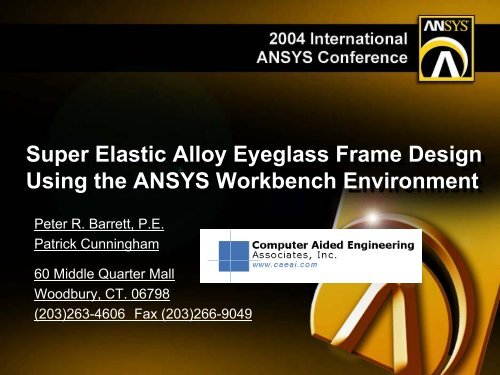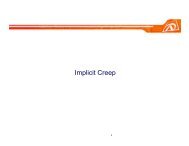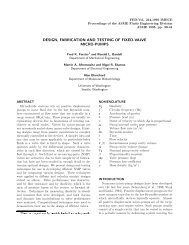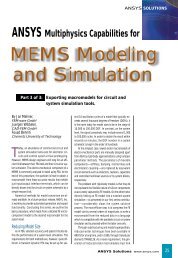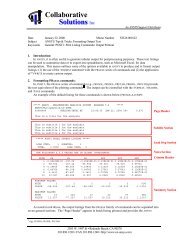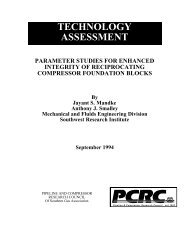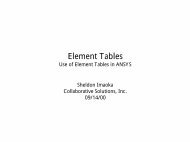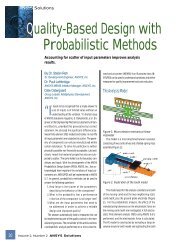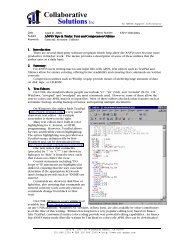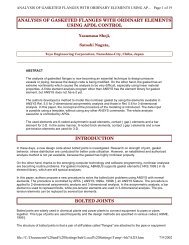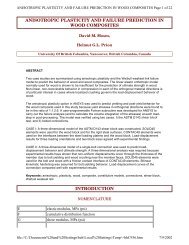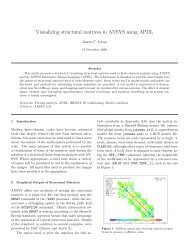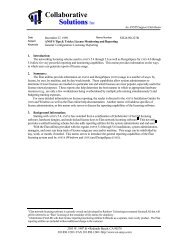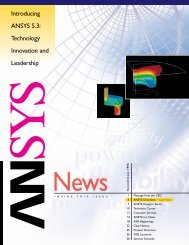Super Elastic Alloy Eyeglass Frame Design Using the ANSYS ...
Super Elastic Alloy Eyeglass Frame Design Using the ANSYS ...
Super Elastic Alloy Eyeglass Frame Design Using the ANSYS ...
Create successful ePaper yourself
Turn your PDF publications into a flip-book with our unique Google optimized e-Paper software.
<strong>Super</strong> <strong>Elastic</strong> <strong>Alloy</strong> <strong>Eyeglass</strong> <strong>Frame</strong> <strong>Design</strong><br />
<strong>Using</strong> <strong>the</strong> <strong>ANSYS</strong> Workbench Environment<br />
© 2004 <strong>ANSYS</strong>, Inc.<br />
Peter R. Barrett, P.E.<br />
Patrick Cunningham<br />
60 Middle Quarter Mall<br />
Woodbury, CT. 06798<br />
(203)263-4606 Fax (203)266-9049<br />
<strong>ANSYS</strong>, Inc. Proprietary
Analysis Goal<br />
• The goal of <strong>the</strong> analysis is to determine <strong>the</strong> configurations of <strong>the</strong><br />
eyeglass frame that can tolerate being stepped on and still be capable<br />
of recovery meeting stiffness design requirements.<br />
© 2004 <strong>ANSYS</strong>, Inc.<br />
<strong>ANSYS</strong>, Inc. Proprietary
Analysis Tools<br />
© 2004 <strong>ANSYS</strong>, Inc.<br />
• Demonstrate <strong>the</strong> use of sensitivity analysis at <strong>the</strong><br />
concept stages of an eyeglass frame design.<br />
• Tools used include:<br />
– The <strong>ANSYS</strong> Workbench Environment<br />
• Parametric geometry is created using <strong>Design</strong>Modeler<br />
• Boundary conditions, material constants, and meshing<br />
controls are defined using <strong>the</strong> Simulation tool.<br />
• Sensitivity studies are run using <strong>Design</strong>Xplorer<br />
– <strong>ANSYS</strong>’s super-elastic material model<br />
<strong>ANSYS</strong>, Inc. Proprietary
Integration of <strong>the</strong> Analysis Tools<br />
© 2004 <strong>ANSYS</strong>, Inc.<br />
<strong>Design</strong>Modeler<br />
• Develop fully parametric geometry<br />
models.<br />
• Remove geometric details that have<br />
little bearing on <strong>the</strong> analysis result.<br />
• Slice up geometry and reform parts<br />
to enable sweep meshing in <strong>the</strong><br />
Simulation tool.<br />
<strong>Design</strong>Xplorer<br />
• Define tolerances on <strong>the</strong> input<br />
• Determine <strong>the</strong> critical parameters of<br />
<strong>the</strong> system.<br />
• Optimize within <strong>the</strong> input/response<br />
characterization.<br />
• Create a deterministic result of <strong>the</strong><br />
optimum configuration.<br />
Simulation<br />
• Define material models.<br />
• Auto or manually define contact<br />
element pairs.<br />
• Apply boundary conditions.<br />
• Apply Solution Controls.<br />
• Debug <strong>the</strong> initial analysis run.<br />
• Define input and output variables for<br />
<strong>the</strong> sensitivity study.<br />
<strong>ANSYS</strong>, Inc. Proprietary
<strong>Design</strong> Modeler Parametric Model<br />
Development<br />
• The geometric model is built<br />
using <strong>the</strong> parametric feature<br />
capabilities of <strong>the</strong><br />
Workbench/<strong>Design</strong>Modeler<br />
tool.<br />
• Each dimension used in <strong>the</strong><br />
development of <strong>the</strong><br />
geometry is converted to a<br />
named parameter that is<br />
accessible as an input<br />
variable for <strong>the</strong> sensitivity<br />
study.<br />
• Parameter relationships and<br />
dependences are defined to<br />
prevent conflicts during<br />
model regeneration<br />
© 2004 <strong>ANSYS</strong>, Inc.<br />
<strong>ANSYS</strong>, Inc. Proprietary
Setting up <strong>the</strong> Analysis Environment<br />
• Once <strong>the</strong> geometry is<br />
complete in <strong>Design</strong>Modeler it<br />
is attached in <strong>the</strong> Simulation<br />
Tool<br />
• Meshing, material properties,<br />
boundary conditions, and<br />
solution controls are defined<br />
in <strong>the</strong> solution tool<br />
• Toggling between <strong>the</strong> design<br />
and analysis tools is possible<br />
at any time using <strong>the</strong><br />
Workbench tabs<br />
© 2004 <strong>ANSYS</strong>, Inc.<br />
<strong>ANSYS</strong>, Inc. Proprietary
Meshing in Workbench<br />
• <strong>Design</strong>Modeler is also<br />
used to slice <strong>the</strong><br />
geometry in <strong>the</strong><br />
desired regions to<br />
enable automatic<br />
sweep meshing in <strong>the</strong><br />
<strong>Design</strong>Simulation<br />
tool.<br />
• Mesh sizing controls<br />
are added in <strong>the</strong><br />
<strong>Design</strong>Simulation<br />
tool.<br />
• A coarse finite<br />
element mesh is used<br />
for this example.<br />
© 2004 <strong>ANSYS</strong>, Inc.<br />
<strong>ANSYS</strong>, Inc. Proprietary
<strong>Super</strong> <strong>Elastic</strong> Material Model<br />
• Nitinol is an acronym for Nickel Titanium Naval<br />
Ordinance Laboratory since <strong>the</strong> alloy was<br />
originally developed at <strong>the</strong> U.S. Naval Laboratory.<br />
• It is used to describe a family of materials, which<br />
contain a nearly equal mixture of nickel and<br />
titanium.<br />
• Nitinol alloys are attractive because <strong>the</strong>y are<br />
biocompatible and are at <strong>the</strong>ir optimum superelastic<br />
behavior (9% strain fully recoverable) at<br />
room temperature when processed properly.<br />
© 2004 <strong>ANSYS</strong>, Inc.<br />
<strong>ANSYS</strong>, Inc. Proprietary
Stress vs. Strain for a Nitinol Material<br />
Model using <strong>ANSYS</strong><br />
© 2004 <strong>ANSYS</strong>, Inc.<br />
• Constant Definition<br />
• SIG-SAS (C1) Starting stress value for <strong>the</strong> forward phase transformation<br />
• SIG-FAS (C2) Final stress value for <strong>the</strong> forward phase transformation<br />
• SIG-SSA (C3) Starting stress value for <strong>the</strong> reverse phase transformation<br />
• SIG-FSA (C4) Final stress value for <strong>the</strong> reverse phase transformation<br />
• EPSILON (C5) Maximum residual strain<br />
• ALPHA (C6) α material responses ratio between tension and compression<br />
• YMRT (C7) Modulus for Martensite (This is Beta in 8.0/8.1)<br />
<strong>ANSYS</strong>, Inc. Proprietary
Material properties<br />
• The material<br />
properties are<br />
defined in <strong>the</strong><br />
Simulation tool<br />
using <strong>the</strong><br />
Preprocessing<br />
Command Builder.<br />
• The Preprocessing<br />
Command Builder<br />
enables access to<br />
<strong>the</strong> <strong>ANSYS</strong><br />
material model<br />
GUI.<br />
© 2004 <strong>ANSYS</strong>, Inc.<br />
<strong>ANSYS</strong>, Inc. Proprietary
Creating Rigid Target Surfaces<br />
• In <strong>the</strong> Workbench Simulation<br />
module contact pairs are<br />
automatically defined between<br />
adjacent parts when <strong>the</strong><br />
geometry is attached.<br />
• For this case we have opted<br />
to define <strong>the</strong> crushing<br />
surfaces as rigid target<br />
elements which do not require<br />
underlying solid elements.<br />
• As a result, <strong>the</strong> rigid target<br />
surfaces and <strong>the</strong> contact pairs<br />
are defined using APDL<br />
commands.<br />
© 2004 <strong>ANSYS</strong>, Inc.<br />
<strong>ANSYS</strong>, Inc. Proprietary
Creating contact pairs using APDL<br />
• The first step in <strong>the</strong> APDL<br />
generation of <strong>the</strong> contact<br />
pairs is to identify <strong>the</strong><br />
surfaces on <strong>the</strong> model<br />
where <strong>the</strong> contact elements<br />
will be generated.<br />
• This is easily done by<br />
defining Named Selections<br />
for <strong>the</strong> top and bottom<br />
surfaces in <strong>the</strong> Simulation<br />
tool.<br />
© 2004 <strong>ANSYS</strong>, Inc.<br />
<strong>ANSYS</strong>, Inc. Proprietary
Named Components in Workbench<br />
• The named surface<br />
selections on <strong>the</strong> solid<br />
geometry will be<br />
transferred to <strong>ANSYS</strong><br />
as nodal components.<br />
• Named Solids will be<br />
transferred as Element<br />
Groups<br />
• Loads are transferred<br />
as surface effect<br />
elements that can be<br />
fur<strong>the</strong>r modified in<br />
<strong>ANSYS</strong><br />
© 2004 <strong>ANSYS</strong>, Inc.<br />
<strong>ANSYS</strong>, Inc. Proprietary
Defining Contact Pairs using APDL<br />
• The Preprocessing<br />
Commands worksheet is<br />
used to define <strong>the</strong> target<br />
elements in <strong>the</strong> following<br />
fashion:<br />
– Use *get commands to<br />
determine <strong>the</strong> maximum<br />
element type number and<br />
real table defined.<br />
– Define new contact and<br />
target element type<br />
numbers.<br />
– Define new real tables for<br />
<strong>the</strong> contact pairs<br />
– Use APDL commands to<br />
directly generate <strong>the</strong> nodes<br />
and elements of <strong>the</strong> rigid<br />
target surfaces.<br />
© 2004 <strong>ANSYS</strong>, Inc.<br />
<strong>ANSYS</strong>, Inc. Proprietary
Defining Contact Pairs using APDL<br />
• The Preprocessing<br />
Commands worksheet<br />
is also used to define<br />
<strong>the</strong> contact elements:<br />
© 2004 <strong>ANSYS</strong>, Inc.<br />
– Select <strong>the</strong> nodal<br />
components of <strong>the</strong> top<br />
and bottom surfaces.<br />
– Select solid elements<br />
attached to <strong>the</strong> nodes.<br />
– Specify element<br />
attributes.<br />
– Use ESURF to generate<br />
<strong>the</strong> contact elements.<br />
<strong>ANSYS</strong>, Inc. Proprietary
Defining Contact Pairs using APDL<br />
© 2004 <strong>ANSYS</strong>, Inc.<br />
Notes:<br />
– A self contact pair is defined around <strong>the</strong> perimeter of<br />
<strong>the</strong> lens frame. This pair could also have been defined<br />
using <strong>the</strong> manual contact capability in <strong>the</strong> Workbench<br />
Simulation tool.<br />
– The target surfaces could also be defined using<br />
surface geometry and <strong>the</strong> resulting shell elements<br />
converted to rigid target elements using <strong>the</strong> EMODIF<br />
command in <strong>the</strong> Preprocessing Commands worksheet.<br />
<strong>ANSYS</strong>, Inc. Proprietary
Boundary Conditions<br />
• The following boundary conditions<br />
are applied to <strong>the</strong> model:<br />
1. A frictionless support is applied<br />
on <strong>the</strong> bridge of <strong>the</strong> glasses to<br />
establish reflective symmetry.<br />
This is applied as a support<br />
inside <strong>the</strong> Simulation<br />
environment.<br />
2. The lower rigid target is fixed in<br />
all degrees of freedom. This<br />
constraint is defined using <strong>the</strong><br />
Processing Command<br />
worksheet.<br />
3. The upper rigid target is<br />
displaced –1” in <strong>the</strong> vertical<br />
direction. This constraint is<br />
defined using <strong>the</strong> Processing<br />
Command worksheet.<br />
© 2004 <strong>ANSYS</strong>, Inc.<br />
<strong>ANSYS</strong>, Inc. Proprietary
Solution Controls<br />
• The nonlinear solution<br />
controls are defined<br />
using <strong>the</strong> Preprocessing<br />
Command Builder.<br />
• Multiple load steps<br />
(loading and unloading)<br />
are defined using <strong>the</strong><br />
solution controls menu.<br />
• Does require adding<br />
SOLVE commands to <strong>the</strong><br />
Preprocessor Command<br />
Builder<br />
© 2004 <strong>ANSYS</strong>, Inc.<br />
<strong>ANSYS</strong>, Inc. Proprietary
Initial Solution in <strong>the</strong> Simulation Tool<br />
• Prior to <strong>the</strong> sensitivity<br />
study, an initial solution<br />
is generated by solving<br />
in <strong>the</strong> Simulation<br />
environment.<br />
• This is not a required<br />
step, but it is always<br />
recommended,<br />
particularly for debugging<br />
<strong>the</strong> nonlinear solution.<br />
© 2004 <strong>ANSYS</strong>, Inc.<br />
<strong>ANSYS</strong>, Inc. Proprietary
Postprocessing <strong>the</strong> initial Simulation<br />
• Postprocessing of <strong>the</strong><br />
initial simulation run can<br />
be done with a<br />
combination of <strong>the</strong><br />
standard Simulation<br />
solution tools and <strong>the</strong><br />
Postprocessing<br />
Command Builder.<br />
• The Simulation<br />
environment only has<br />
access to <strong>the</strong> last<br />
converged solution and<br />
<strong>the</strong> results are limited to<br />
linear quantities with <strong>the</strong><br />
exception on contact<br />
results.<br />
© 2004 <strong>ANSYS</strong>, Inc.<br />
<strong>ANSYS</strong>, Inc. Proprietary
Postprocessing <strong>the</strong> initial simulation<br />
• The Postprocessing<br />
Command builder can be<br />
used to look at <strong>the</strong> full<br />
contents of <strong>the</strong> <strong>ANSYS</strong><br />
result file.<br />
• All results steps written<br />
to <strong>the</strong> <strong>ANSYS</strong> result file<br />
are accessible.<br />
• All nonlinear results are<br />
accessible<br />
• Time history plots and<br />
result combinations are<br />
also possible using <strong>the</strong><br />
result viewer.<br />
© 2004 <strong>ANSYS</strong>, Inc.<br />
<strong>ANSYS</strong>, Inc. Proprietary
Time History plots using <strong>the</strong> Postprocessing<br />
Command Builder<br />
• The Postprocessing Command builder can be used to plot <strong>the</strong><br />
hysteresis response of <strong>the</strong> shape memory alloy.<br />
© 2004 <strong>ANSYS</strong>, Inc.<br />
<strong>ANSYS</strong>, Inc. Proprietary
Time History plots using <strong>the</strong> Postprocessing<br />
Command Builder<br />
• Result plots and<br />
listings from <strong>the</strong><br />
Postprocessing<br />
Command Builder<br />
can be returned to<br />
<strong>the</strong> Simulation<br />
Environment.<br />
These figures are<br />
<strong>the</strong>n included in <strong>the</strong><br />
design report.<br />
© 2004 <strong>ANSYS</strong>, Inc.<br />
<strong>ANSYS</strong>, Inc. Proprietary
Setting up <strong>the</strong> Sensitivity study environment<br />
• Once <strong>the</strong> initial solution is<br />
resolved, input and output<br />
variables for <strong>the</strong> sensitivity<br />
study are defined in <strong>the</strong><br />
simulation environment.<br />
• Input and output variables are<br />
defined by checking <strong>the</strong> box to<br />
<strong>the</strong> left of <strong>the</strong> parameter.<br />
• In this case we specify <strong>the</strong><br />
defining geometric parameters<br />
as <strong>the</strong> input variables<br />
© 2004 <strong>ANSYS</strong>, Inc.<br />
<strong>ANSYS</strong>, Inc. Proprietary
Setting up <strong>the</strong> Sensitivity study environment<br />
• The output variables<br />
for this study are <strong>the</strong><br />
Von Mises stress and<br />
<strong>the</strong> deformation in <strong>the</strong><br />
load direction.<br />
• The stress can be used<br />
to simulate <strong>the</strong> elastic<br />
response, while <strong>the</strong><br />
displacement is used<br />
to measure stiffness<br />
© 2004 <strong>ANSYS</strong>, Inc.<br />
<strong>ANSYS</strong>, Inc. Proprietary
DOE Method of <strong>Design</strong> Explorer<br />
• When <strong>the</strong> data is<br />
attached to a<br />
<strong>Design</strong>Xplorer<br />
session, <strong>the</strong> upper<br />
and lower bounds<br />
(or discrete values)<br />
of <strong>the</strong> input variables<br />
must be defined.<br />
© 2004 <strong>ANSYS</strong>, Inc.<br />
<strong>ANSYS</strong>, Inc. Proprietary
<strong>Design</strong> Explorer DOE – Solution<br />
• For <strong>the</strong> DOE method<br />
used by<br />
<strong>Design</strong>Xplorer <strong>the</strong><br />
number of<br />
deterministic<br />
solutions required is<br />
automatically<br />
determined based<br />
on <strong>the</strong> number of<br />
input variables.<br />
© 2004 <strong>ANSYS</strong>, Inc.<br />
<strong>ANSYS</strong>, Inc. Proprietary
<strong>Design</strong> Explorer DOE – Solution<br />
• Sensitivity of Max.<br />
Von Mises stress vs.<br />
<strong>Frame</strong> thickness and<br />
<strong>Frame</strong> bottom radius<br />
are illustrated in <strong>the</strong><br />
Figure.<br />
• As expected <strong>the</strong> larger<br />
<strong>the</strong> larger radius /<br />
thinner frame<br />
produces <strong>the</strong> lowest<br />
stress values<br />
• Specific data is<br />
extracted from <strong>the</strong><br />
Response Tabs<br />
© 2004 <strong>ANSYS</strong>, Inc.<br />
<strong>ANSYS</strong>, Inc. Proprietary
<strong>Design</strong> Explorer DOE – Solution<br />
• “Soft” <strong>Design</strong> Sets<br />
are created in<br />
<strong>Design</strong> Explorer<br />
directly from <strong>the</strong><br />
DOE<br />
• A chosen design can<br />
<strong>the</strong>n be run explicitly<br />
to get <strong>the</strong> hard<br />
design results<br />
• Data can also be<br />
exported to a<br />
spreadsheet for<br />
integration into<br />
design rules, etc.<br />
© 2004 <strong>ANSYS</strong>, Inc.<br />
<strong>ANSYS</strong>, Inc. Proprietary
Conclusions<br />
• The combination of design modeler,<br />
design simulation and design<br />
explorer provide a valuable tool for<br />
upfront engineering<br />
• Complex material models and<br />
Highly nonlinear analyses were<br />
easily adapted into <strong>the</strong> workbench<br />
environment<br />
• Sensitivity results (example on<br />
right) provide valuable data for <strong>the</strong><br />
design engineer to quickly<br />
determine <strong>the</strong> most relevant design<br />
parameters<br />
© 2004 <strong>ANSYS</strong>, Inc.<br />
<strong>ANSYS</strong>, Inc. Proprietary


